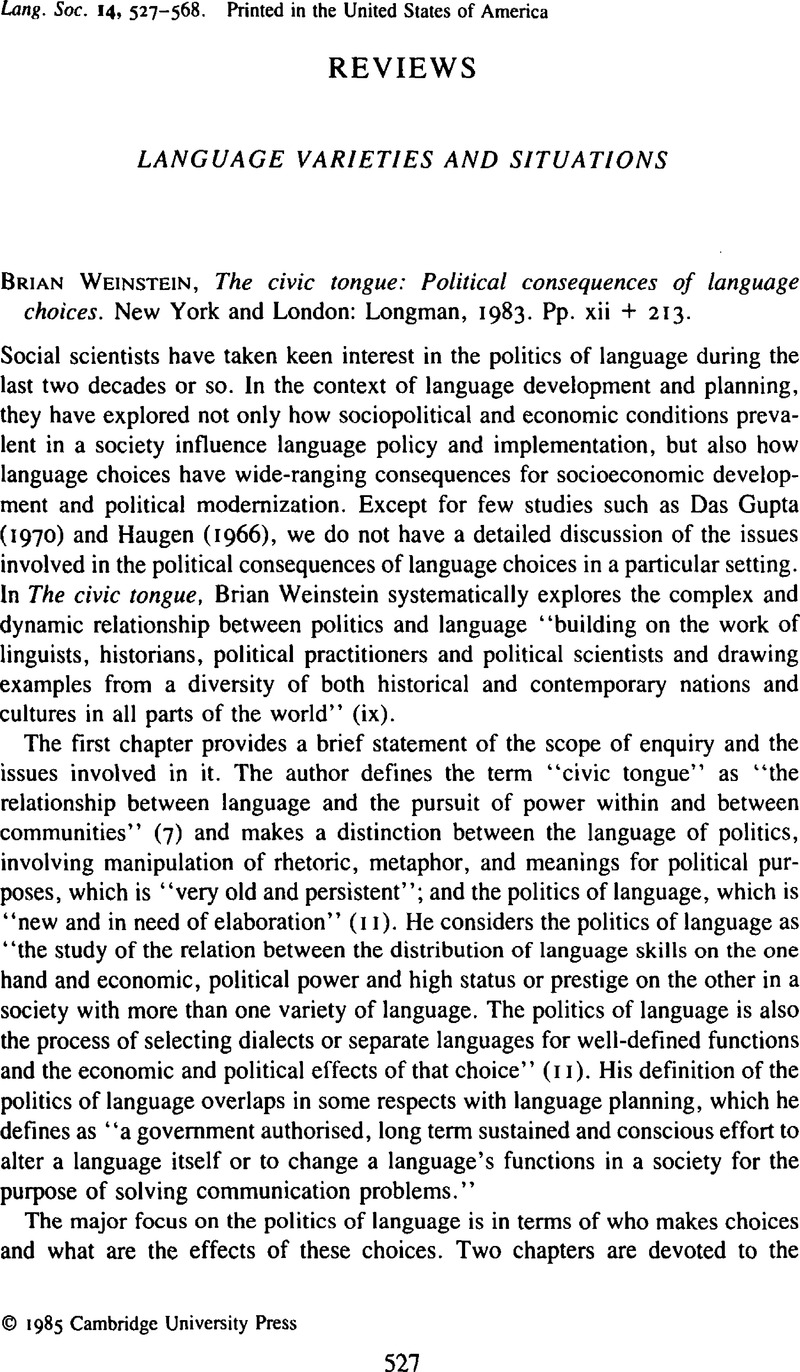No CrossRef data available.
Article contents
Language Varieties and Situations - Brian Weinstein, The civic tongue: Political consequences of language choices. New York and London: Longman, 1983. Pp. xii + 213.
Review products
Brian Weinstein, The civic tongue: Political consequences of language choices. New York and London: Longman, 1983. Pp. xii + 213.
Published online by Cambridge University Press: 18 December 2008
Abstract
An abstract is not available for this content so a preview has been provided. Please use the Get access link above for information on how to access this content.

Information
- Type
- Book Review
- Information
- Copyright
- Copyright © Cambridge University Press 1985
References
REFERENCES
Das, Gupta J. (1970). Language conflict and national development; Group politics and national language policy in India. Berkeley: University of California Press.Google Scholar
Das, Gupta J. (1973). Language planning and public policy: Analytical outline of the policy process related to language planning in India. In Shuy, R. (ed.), The Twenty-Third Annual Round Table Meeting on Linguistics and Language Studies. Washington, D.C., Georgetown University Press.Google Scholar
Das, Gupta J. (1976). Practice and theory of language planning. In O'Barr, M. and O'Barr, J. (eds.), Language and politics. The Hague: Mouton. 195–212.Google Scholar
Dua, H. R. (forthcoming). Language planning in India.Google Scholar
Fishman, J. A. (1968). Nationality-nationalism and nation-nationism. In Fishman, J. A., Ferguson, C. A., & Gupta, J. Das (eds.), Language problems & developing nations. New York: John Wiley & Sons.Google Scholar
Fishman, J. A. (1977). The spread of English as a new perspective for the study of “language maintenance and language shift.” In Fishman, J. A., Cooper, R. L., & Conrad, A. W. (eds.), The spread of English. Rowley, Mass.: Newbury House.Google Scholar
Glazer, N. (1978). The process and problems of language maintenance: An integrated view. In Lourie, M. A. & Conklin, N. F. (eds.), A pluralistic Nation. Rowley, Mass.: Newbury House.Google Scholar
Haugen, E. (1966). Language conflict and language planning: The case of Modern Norwegian. Cambridge, Mass.: Harvard University Press.CrossRefGoogle Scholar
Laitin, D. (1977). Politics, language and thought: The Somali experience. Chicago: University of Chicago Press.Google Scholar
Neustupný, J. V. (1983). Towards a paradigm for language planning. Language Planning News Letter 9(4):1–4.Google Scholar
Pattanayak, D. P. (1980). Linguistic pluralism and mother tongue education: The Indian context. Delhi: Oxford University Press.Google Scholar
Srivastava, R. N. (1977). Indian bilingualism: Myth and reality. In Sharma, P. Gopal & Kumar, S. (eds.), Indian bilingualism. Agra: Kendriya Hindi Sansthan.Google Scholar
Tollefson, J: W. (1981). Centralized and decentralized language planning. Language Problems and Language Planning 5(2):175–88.CrossRefGoogle Scholar

